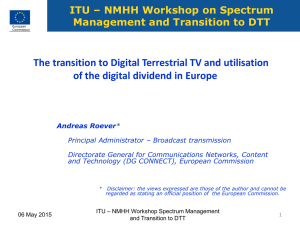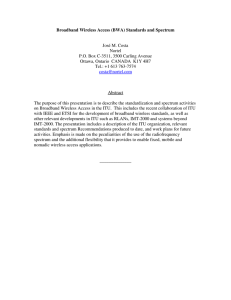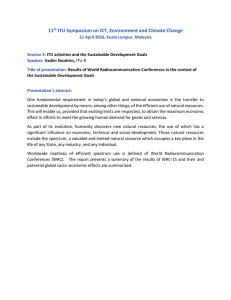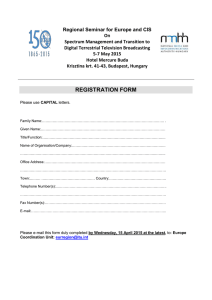Utilization of Digital Dividend The broadcast industry view Bernard Pauchon
advertisement
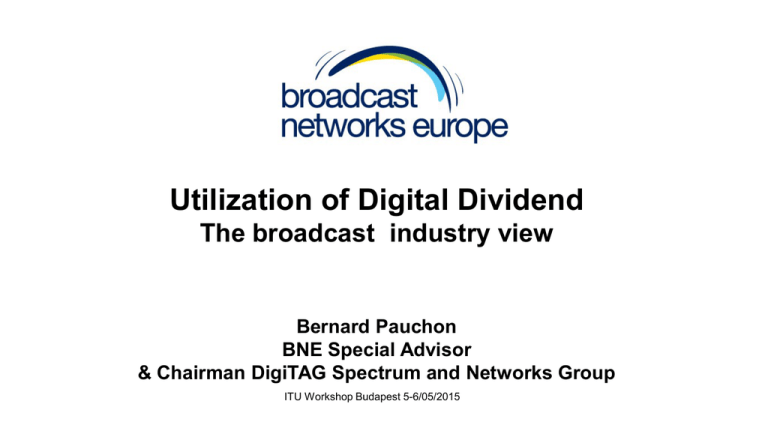
Utilization of Digital Dividend The broadcast industry view Bernard Pauchon BNE Special Advisor & Chairman DigiTAG Spectrum and Networks Group ITU Workshop Budapest 5-6/05/2015 Agenda • About Broadcast Networks Europe • 800 MHz band a true win-win Digital Dividend • Future use of UHF below 800 MHz • EU and CEPT views • Conclusion ITU Workshop Budapest 5-6/05/2015 BNE - Members operating in 21 countries • A trade organisation for Terrestrial Broadcast Network Operators for Radio and TV in Europe based in Brussels • Long term opportunities for terrestrial broadcasting • Current issues: – Spectrum 700 MHz, UHF-band – Interference, Co-existence – New Services BNE Member Membership Discussions. Ex TDF. BNE Membership Discussions ITU Workshop Budapest 5-6/05/2015 BNE 17 members, 20 countries UK Spain Germany Italy Romania Czech Republic Italy Norway, Belgium Ireland Greece Finland Croatia Austria France, Estonia, (Poland), Monaco ITU Workshop Budapest 5-6/05/2015 Serbia Switzerland Sweden, Denmark 800 MHz band : a true win-win digital dividend ITU Workshop Budapest 5-6/05/2015 DD1 ( 800 MHz band) : a true win-win digital dividend • More spectrum for MNO for implementing new technology • More television channels with better picture quality including HD for Consumers • Transmission costs reduced for broadcasters • Good income for governments ITU Workshop Budapest 5-6/05/2015 Future use of UHF below 800 MHz ITU Workshop Budapest 5-6/05/2015 WRC-12 decisions ● Resolution that WRC 2015 will decide to have immediately a coprimary allocation of 700Mhz band between broadcasting and with mobile services, subject to positive results of work on compatibility studies( ITU WRC 15 agenda item 1.2) This will create an opportunity for whoever wishes to use it, but no obligation for whoever does not wish so ● Identify additional spectrum for IMT( ITU WRC 15 agenda item 1.1) ● For those two purposes, ITU had established a joint task Group ( JTG 4-5-6-7) for carrying out the necessary related studies ITU Workshop Budapest 5-6/05/2015 8 Some comments on WRC decisions One can fully understand why African and Arab States have pushed for the WRC decision on 700 MHz – 800MHz often currently occupied by various services – Late introduction of DTT allows for doing this with DVB-T2, the most efficient Digital Television Standard, and hence the least spectrum consuming – Why then should they spend money for clearing 800MHz band, when they have enough spectrum available below for deploying DTT services North of Region 1 is in a completely different situation: • 800 MHz band has been ( or is to be) cleared from broadcast services, and services start to be deployed in this band: Europe is still to reap the full benefits of the 800 MHz band (and 900 MHz), and with this as already roughly same amount of spectrum for IMT as the other regions • The case for more sub 1GHz spectrum for Wireless Broadband is unproven • Consumers have embraced DTT and any further displacement of DTT services will likely cause considerable disruption and cost ITU Workshop Budapest 5-6/05/2015 TV Reception, EU28 Households Terrestrial; 46% Cable; 31% Satellite; 23% Broadband; 10% “Terrestrials” - approx: >100 million households >250 million people 45-50% of Europeans 2000 TV Channels Data from Eurobarometer 396, 2013 and Mavise. Adds to more than 100%. Households may use more than one platform. ITU Workshop Budapest 5-6/05/2015 DTT is a Great Success Story • • • • • • • • • DTT is now launched in nearly all North of Region 1 countries. DTT networks now serves some 2000 TV channels, about 50% of European households with 250 million viewers, each spending some 4 hours watching linear TV every day. In addition, secondary TVs rely on DTT. Free to Air at point of consumption More than 1 billion TV receivers with integrated DTT tuners are now in use around the world. Low cost for media delivery. Network cost is typically between € 0.2-1 per household per month for up to 60 channels distributed 24/7. Per channel distribution cost can be as low as € 1c per household per month. Very easy access for consumers and no cost at point of consumption of a wide offering of free-to-air content. DTT is a key pillar for European content creation. ITU Workshop Budapest 5-6/05/2015 DTT has a spectacular growth and is an innovative technology and a lively service • From just a few channels per country to more than 50 digital channels including HDTV and 3DTV • DTT in Europe serves 275 million people and provides 1800+ TV channels • Free-to-Air Public Service, Commercial TV and Pay-TV • About 200 Million DTT enabled receivers sold in Europe • Kitchen-TVs, Bedroom-TVs, Second Homes, Caravans etc represent an additional significant share • Simple to use and install, reliable and universally available • Demand for linear TV is growing – quite the reverse of common myths ITU Workshop Budapest 5-6/05/2015 Some key attributes of the DTT technology ● High availability and reliability of service; ● The capability to deliver local and regional content; ● National coverage beyond just high population density areas; ● QoS independent of the number of simultaneous viewers; ● Ease of reception via portable or existing roof mounted aerials; ● Supports both Free-to-Air channels that are free at the point of consumption and encrypted channels ITU Workshop Budapest 5-6/05/2015 DTT Networks: Cost efficient, Spectrum efficient, Reliable 0,1 – 2 € per household per month to distribute up to 60 TV channels 24/7 with high Quality of Service Distribution cost per channel ≈0,01€ per household per month BNE has conducted studies showing that using High Power/High Towers whenever possible is the most cost efficient way of DTT delivery ITU Workshop Budapest 5-6/05/2015 IMT industry is always looking for new spectrum, BUT ● Refarming of existing IMT spectrum which is currently occupied by legacy systems, e.g. GSM and EDGE, should be prioritised ● Greater emphasis on the importance of Wi-Fi offload and Small Cells to deliver the growth in data traffic ● Due consideration given to the extent to which traffic is truly mobile, i.e. subject to cell handover ● Greater scrutiny be given to growth forecasts for wireless broadband traffic with key forecasts recently revised down. ● Wireless Broadband is not limited to Mobile Broadband, and includes WiFi as well as satellite. In EU, the goal set in the RSPP of identifying 1200 MHz spectrum for Wireless Broadband by 2015 is already met ITU Workshop Budapest 5-6/05/2015 Analysys Mason on the mobile data explosion • Most mobile data growth forecasts are wildly exaggerated • Fixed broadband soaks up a huge share of small- and mid-screen wireless device data. • Long-term demand for bandwidth-intensive data in locations where the fixed/Wi-Fi is not available is not great. • Year to year mobile data traffic growth rate is declining • 19 out of 20 surfpads sold in Europe are WiFi-only ITU Workshop Budapest 5-6/05/2015 Ref. The collapse in the value of the mobile gigabyte: myth and reality. Analyses Mason Jan 6, 2012 Efficiency of DTT for data traffic: DTT networks reality compared to Cisco Mobile Traffic Forecast 100 million households 4 hours per day. (A conservative estimate) Note that most of Mobile Data Growth will occur in North America and Asia Pacific according to the Cisco forecast 18 Data traffic generated by ONE DTT Standard Definition TV Channel Data Traffic Consumed 2013 from DTT Networks for ONE standard Definition Television channel across EU28. 16,2 EB/month 2013 ITU Workshop Budapest 5-6/05/2015 Global Mobile Data Traffic Forecast ExaByte/month (1E+18) By region Cisco VNI Mobile On the opposite, DTT is constantly developing with no request for more spectrum 21 470- 22 23 24 25 26 27 28 29 30 31 32 33 34 35 36 37 38 39 40 41 49 694- 50 51 52 53 54 55 56 57 58 59 60 61 62 63 64 65 66 67 68 69 -862 21 470- 22 23 24 25 26 27 28 29 30 31 32 33 34 35 36 37 38 39 40 41 49 694- 50 51 52 53 54 55 56 57 58 59 60 61 62 63 64 65 66 67 68 69 -862 21 470- 22 23 24 25 26 27 28 29 30 31 32 33 34 35 36 37 38 39 40 41 49 694- 50 51 52 53 54 55 56 57 58 59 22 23 24 25 26 27 28 29 30 31 60 -790 79032 33 42 35 36 37 38 39 40 41 44 45 46 42 43 44 45 46 Analogue 42 Digital tv Analogue only. 47 48 -694 Simulcast. Analogue SD Few channels 43 44 45 46 42 43 44 45 46 Mobile ITU Workshop Budapest 5-6/05/2015 ???- 224 MHz? & Digital SD and HD 47 48 -694 All digital. Many SD & HD channels interactive services 47 48 -694 How many??? SD, HD and UHD channels and 2015 - 312 MHz -862 Simulcast 48 -694 2005 - 412 MHz 470694- 702702 47 1995 - 412 MHz -862 34 43 interactive services? Technical innovation is essential, but be careful and smart when using it ! DVB-T + MPEG2 Spectrum per programme programme Today DVB-T + MPEG4 DVB-T2 + MPEG4 Early DTT Early HDTV +Other DTT DVB-T2 + HEVC Other HDTV +Final DTT ITU Workshop Budapest 5-6/05/2015 19 19 Time Future developments of DTT technology(1/2) ● DVB-T2 networks are currently implemented using the H.264/AVC video compression format. Introducing the next generation of video compression format, H.265/HEVC, would further increase the channel capacity of DVB-T2 multiplexes. ● In addition, the DVB-T2 feature known as Multiple Physical Layer Pipes allows independent adjustment of parameters for each delivered programme service within a channel multiplex to meet the required reception conditions (for example outdoor or roof-top antenna). It also allows DTT receivers to save power by decoding only a single program service rather than the whole multiplex of services. ITU Workshop Budapest 5-6/05/2015 Future developments of DTT technology(2/2) ● The DVB-T2 standard allows networks to be configured to deliver programme service content to mobile and handheld devices. This feature of DVB-T2 networks could complement mobile broadband networks and be used to offload a significant amount of traffic reducing costs (both for the consumer and mobile broadband network operators) and offering improved QoS. Thanks to a mechanism of the DVB-T2 specification called FEF( Future Extension Frame), other signals such as the relevant sub-set of the DVBT2 specification called T2-Lite can be inserted within the DVB-T2 transmission profile, but other technologies such as LTE can also be inserted as well ! ● DTT technology and services are expected to further develop in the future, thus creating recurrent needs for technological upgrades (for both consumers and broadcasters) and hence scope for simulcast of new and existing services. ● DTT technology is already well cooperating with fixed broadband technology( connected TV) ITU Workshop Budapest 5-6/05/2015 Technical innovation provides opportunities, but be careful! • Opportunities – Spectrum is a scarce resource, but is needed for introducing new services, so that the DTT platform keeps its attractiveness in comparison with other plaforms – Use of T2 for countries not having yet DTT, or for introducing new services( i.e. HD) for countries not having it yet( UK, Sweden…) is the right thing to do • But be careful! – The current context where there is pressure for finding additional spectrum for Wireless Broadband, leads to create pressure on the early DTT adopters for migrating towards the more efficient technology that is T2 – But introducing new technology at the occasion of launching new services( what France, Italy, Spain… did with MPEG4 for HD, and UK, Sweden… with T2) is one thing, to migrate existing services is a completely different thing, and is equivalent to a transition from Analogue to Digital , WITHOUT ANY BENEFIT FOR CONSUMERS! ITU Workshop Budapest 5-6/05/2015 Spectrum needs for broadcasting(1/2) ● Whilst the means by which you introduce DTT service enhancements(HD, 3D, 4K…) is likely to initially be via the widespread introduction of DVB-T2 services there is currently no plan to or timetable for the current services to be delivered utilising DVB-T2. ● Furthermore, since the spectrum ch. 21 – 60 is extensively utilised to provide existing services it is unclear how such a transition may be facilitated, i.e. where will the additional spectrum for any simulcast arrangements come from and this aspect needs to be considered within the long term provision of spectrum for terrestrial broadcasting, i.e. how can platform evolution be taken account of in future spectrum arrangement. ● Finally, whilst a move from DVB-T to DVB-T2 service delivery would provide for spectrum efficiency gains in the long run, in the short term it is very likely that transitional spectrum would be needed to facilitate such a service / consumer migration and such a transition would take a number of years. ITU Workshop Budapest 5-6/05/2015 Spectrum needs for broadcasting(2/2) ● Whilst gains associated with a move to DVB-T2 could make it easier to enable the introduction of DTT service enhancements, the extent to which these services are introduced will determine the long term requirements of spectrum for the provision of terrestrial broadcast services. It is therefore difficult to be definitive over the exact amount of spectrum needed. ● What is meant by enhancement of services? – Introduction of HD: depends on countries, but many have already HD – 4K: not only a question of resolution, but may be needed for having 3D without glasses – What we do not know yet ● However, it is likely that the amount of spectrum necessary will not be dissimilar to that which will be utilised after clearance of the 800MHz band, i.e. ch. 21 – 60, recognising that spectrum efficiency gains realised through the adoption of DVB-T2 and future higher performing standards will be offset by the higher bandwidth requirements of new enhanced ITU Workshop Budapest 5-6/05/2015 services. EU and CEPT activities related to the future of UHF band ● EU( Council and Parliament) has set up an RSPP, which includes a spectrum inventory ● Activities of the European Commission, and RSPG – – – – – – – – Efficiency of spectrum use RSPG Opinion on Wireless Broadband EC Study by Analysis Mason on spectrum needs EC study by Plum on convergence High Level Group chaired by Pascal Lamy RSPG Opinion on Future of UHF Band RSPG Opinion on Common Policy Objectives for WRC 15 EC to prepare a Communication/Decision for the May Telecom Council ● Activities of the CEPT – CEPT/ ECC activities about future strategy for the use of the whole UHF band and answer to EC mandate to CEPT for studies related to 700 MHz ITU Workshop Budapest 5-6/05/2015 25 EU RSPP – Spectrum Inventory The first results of the EC Spectrum inventory show that spectrum for TV is well and efficiently used in most EU member states. Certain other parts of spectrum can be seen to be barely or inefficiently used ITU Workshop Budapest 5-6/05/2015 Spectrum use FM Radio Actual measurements of spectrum use show that services like FM radio, TV, GSM 900, GSM 1800, 3g and WiFi fill assigned spectrum well whereas other spectrum exhibits less actual TV GSM GSM 900 1800 ITU Workshop Budapest 5-6/05/2015 3G WiFi Source: Valenta, V. et al. (2010) “Survey on Spectrum Utilization in Europe Possible DD2 (700 MHz): Not a dividend for All! • Clear benefits for MNOs and mobile broadband equipment manufacturers • Interest for further income for governments( not necessarily as early as ecpected! BUT • No benefit for broadcasters, but clear burden, not easy to be managed ! • So no more mention of DD2, but reference to use 700 MHz for IMT! ITU Workshop Budapest 5-6/05/2015 Broadcast industry cannot support clearing 700 MHz band, BUT… …in the event that, for well proven reasons, it will decided to displace DTT from the 700 MHz band in favour of mobile broadband we emphasize that the following aspects should be addressed: – All current TV channels and other audiovisual services must remain on air and have the option to migrate to HD The incremental costs of any transition from, and clearance of, the 700MHz band must be compensated (included the amortization one’s due to the recent switch off). A managed transition to DVB-T2 will likely be necessary for a number of Member States. This managed transition will require access to the 700 MHz band for a period of time, during which simulcast transmissions will be necessary. The complexity and practicability of such a clearance and transition will vary among countries. Furthermore, the exposure limits imposed to ensure minimal human health hazards due to electromagnetic radiation would constraint the use of both the 700 MHz and the 800 MHz band on the same mobile base stations, making it more difficult and costly the mobile services network deployment at 700 MHz ITU Workshop Budapest 5-6/05/2015 International and European coordination, as well as coexistence between DTT and LTE at national level will be more challenging than that associated with the 800 MHz band, because : • The 700 MHz band is heavily used for DTT, and hence a displacement of broadcast services out of this band to be constrained to the range 470 – 694 MHz will further concentrate the utilization of broadcast frequencies in Europe requiring more difficult bi-lateral and multi-lateral negotiations with no certainty that services can be maintained. • For LTE, the proposed band plan for 700 MHz has a different positioning of uplink and downlink in the 700MHz band as compared to what is in place in the 800 MHz band. As a consequence, reallocation of the 700 MHz band will raise bigger challenges and costs to avoid the risks of interferences to DTT below 700 MHz (and from DTT to LTE smart phones) • See outcome of ITU CPM text on ITU studies for WRC 15 Ais 1.1 and 1.2 ITU Workshop Budapest 5-6/05/2015 What about the idea of co-primary allocation for IMT below 700 Hz? • While co-primary allocation of the whole UHF band at WRC 15 might appear to be an attractive position, adding flexibility at apparently no direct adverse effect on DTT, it would in reality send a clear message to the terrestrial broadcasting industry, to their viewers and to consumer electronics manufacturers and their retailers that the future of DTT is uncertain, thereby undermining business models of commercial and public players who depend on reasonable certainty to make long term investment decision. • This is well recognized by the European Commission, as stated again during the last month ECCEPT/CPG workshop, recognizing the some frequency band has not only to be dealt with in terms of ITU mechanism perspective, but have clearly political implications. • Long term certainty for DTT in the UHF at least below 700 MHz band must be guaranteed. Not doing so would preclude the investments in DTT evolution which will be needed in the years to come and furthermore would only weaken the core free to air business model of DTT, and therefore impact the whole European audiovisuel content production industry. This has lead to the recent creation of the WSG initiative ITU Workshop Budapest 5-6/05/2015 The WSG initiative ITU Workshop Budapest 5-6/05/2015 Where are we standing on this? • Aetha Report: No economic case to give sub 700 MHz spectrum to mobile • EC Convergence Study: No case for converged DTT – Mobile networks • The Lamy report and the RSPG (Radio Spectrum Policy Group) concludes that DTT is important for the foreseeable future which is 2030 and beyond. ITU Workshop Budapest 5-6/05/2015 The Aetha report – value of spectrum to mobile Our results show that even in the most aggressive mobile traffic forecast, the costs of clearing DTT from the spectrum (EUR38.5bn) significantly outweigh the potential value of using the spectrum for mobile (EUR10.3bn) by a factor of almost four. When a less aggressive traffic forecast is used, the costs of clearing DTT are unchanged but the value of using the spectrum for mobile would be near to zero. ITU Workshop Budapest 5-6/05/2015 Key assumptions retained by CEPT about evolution of A/V delivery services ● ● ● ● ● ● ● ● ● ● ● Broadcasting services will continue to evolve by improvements in picture quality and user experience through the introduction of HDTV, UHDTV, 3DTV, etc; Linear viewing will remain the main way of viewing TV content for the foreseeable future. Time-shifted and on-demand (non-linear) AV content viewing will continue to grow, driven by services such as YouTube, Netflix, or BBC iPlayer; Currently the majority of TV viewing, both linear and non-linear (catch-up), occurs in the home; On mobile devices, viewing of video content outside the home represents about 40% of total viewing on these devices; Most TV viewing will remain on the large screen, while viewing on handheld devices will increase. In the home, the latter is currently driven by the availability of WiFi; Migration of services from SDTV to HDTV, and the introduction of UHDTV services as well addition of interactive services complementing the main stream; In many countries, HDTV programmes are already offered on the DTT platform and satellite, and this could be expected to become the norm in the short to medium term. Hybrid broadcast-broadband services will become commonplace, possibly including a wireless broadband element, to allow increased access to non-linear as well as linear content; New mobile devices, tablets and smartphones, facilitate better user experience for mobile AV content. Mobile broadband services are undergoing growing demand which is causing a significant increase data traffic. The largest and fastest growing traffic type is on-demand video but consumers also rely on mobile broadband for a wide variety of other mobile applications; ITU Workshop Budapest 5-6/05/2015 Conclusions drawn by EU and CEPT ● EU : Pascal Lamy report has been key for : – RSPG Opinion on Future of UHF Band (preserving DTT use of spectrum below 694 MHz at least till 2030, and also proposed solutions for PMSE) and – RSPG Opinion on WRC 15 recommending no mobile allocation below 694 MHz – EC to prepare a Communication or a Decision for the May Telecom Council ● CEPT: ECC/ TG6 report which has resulted in the decision of ECC/ CPG to prepare a CEPT European Common Proposal (ECP) is underway to the WRC-15 with no change of allocation of spectrum below 694 MHz (no co-primary allocation for the mobile service at the WRC15) ITU Workshop Budapest 5-6/05/2015 CONCLUSION Be carefull if planning to use 700 MHz band for IMT • DTT needs spectrum certainety to innovate, and develop new services( HD, 3D, UHD…), and to secure the investments that are necessary for removing broadcasting from 700 MHz if, where and when decided • The 470-694MHz frequency range will be relevant and necessary for DTT services in the EU until 2030 and beyond) • Debates around 700 MHz are already creating disturbances for the DTT service. There is no need to further add on this by adressing the spectrum below NO Change @ upcoming WRCs for spectrum below 700 MHz band ITU Workshop Budapest 5-6/05/2015 Thank you for your attention www.broadcast-networks.eu www.digitag.org ITU Workshop Budapest 5-6/05/2015
